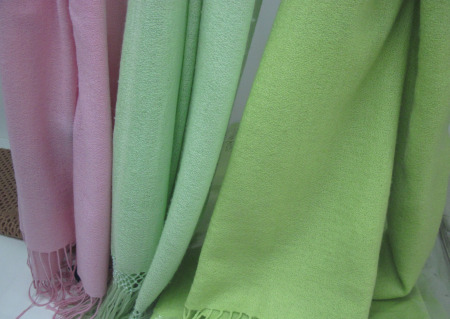|
Cashmere Pashmina
The history of pashmina starts in Kashmir, India back in 3rd century BC. Pashmina comes from the name Persian word Pashmineh, which means "wool." Pashmina wool is made from the changthangi or pashmina goat, and this breed of goat is found in the high altitudes in the Himalayas. For centuries the wandering tribes would hand spin pashmina scarves and other types of clothing. The pashmina fabric is known for being extremely soft, silky, and lustrous; these qualities are due to pashmina being hand-woven over a silk wrap. The silk wrap is added because pashmina is very light weight and fragile. Most often cashmere pashmina is made from 30% silk. When this fabric is dyed, it is placed in open containers. After the dying process is completed, then hand-embroidery, beading and printing is added. These methods are still being employed after several centuries.

Besides the graceful look of a pashmina scarf or shawl, you will also notice the warmth that pashmina gives. If you select a 100% pure cashmere pashmina accessories, then the fabric will be warmer than a pashmina silk blend. It's amazing that such a light-weight fabric can offer such warmth and comfort. A pashmina scarf or shawl is perfect for cold winter months. The silk content percentage is marked on pashmina items; so you can use this as a reference when selecting the amount of warmth you want from a pashmina scarf or shawl. Another factor contributing to the warmth of the fabric is the ply. You can select different ply levels such as 1 ply, 2 ply or 3 ply. Pashmina for many is a luxury fabric. There are many types of clothing that are made from pashmina. You have a variety of breathtaking colors, designs and price ranges to choose from. Once you purchase a cashmere pashmina scarf or shawl, you will understand why this fabric has been loved and popular throughout the ages.
Return from Cashmere Pashmina to Cashmere Expert
|




